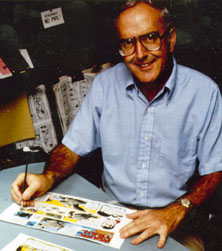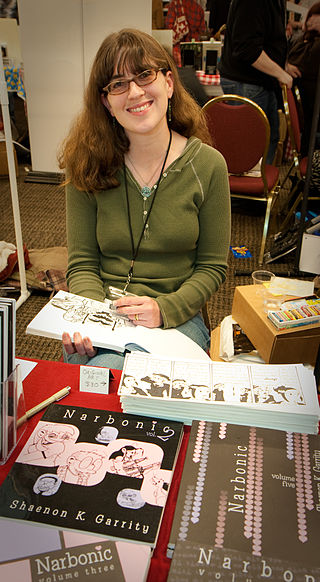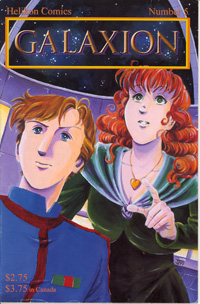Pulp magazines were inexpensive fiction magazines that were published from 1896 to the late 1950s. The term "pulp" derives from the cheap wood pulp paper on which the magazines were printed. In contrast, magazines printed on higher-quality paper were called "glossies" or "slicks". The typical pulp magazine had 128 pages; it was 7 inches (18 cm) wide by 10 inches (25 cm) high, and 0.5 inches (1.3 cm) thick, with ragged, untrimmed edges.

Murray Leinster was a pen name of William Fitzgerald Jenkins, an American writer of genre fiction, particularly of science fiction. He wrote and published more than 1,500 short stories and articles, 14 movie scripts, and hundreds of radio scripts and television plays.

A graphic novel is a long-form, fictional work of sequential art. The term graphic novel is often applied broadly, including fiction, non-fiction, and anthologized work, though this practice is highly contested by comics scholars and industry professionals. It is, at least in the United States, typically distinct from the term comic book, which is generally used for comics periodicals and trade paperbacks.

Comics is a medium used to express ideas with images, often combined with text or other visual information. It typically takes the form of a sequence of panels of images. Textual devices such as speech balloons, captions, and onomatopoeia can indicate dialogue, narration, sound effects, or other information. There is no consensus amongst theorists and historians on a definition of comics; some emphasize the combination of images and text, some sequentiality or other image relations, and others historical aspects such as mass reproduction or the use of recurring characters. Cartooning and other forms of illustration are the most common image-making means in comics; fumetti is a form that uses photographic images. Common forms include comic strips, editorial and gag cartoons, and comic books. Since the late 20th century, bound volumes such as graphic novels, comic albums, and tankōbon have become increasingly common, while online webcomics have proliferated in the 21st century.
Webcomics are comics published on a website or mobile app. While many are published exclusively on the web, others are also published in magazines, newspapers, or comic books.

A cartoonist is a visual artist who specializes in both drawing and writing cartoons or comics. Cartoonists differ from comics writers or comic book illustrators in that they produce both the literary and graphic components of the work as part of their practice. Cartoonists may work in a variety of formats, including booklets, comic strips, comic books, editorial cartoons, graphic novels, manuals, gag cartoons, storyboards, posters, shirts, books, advertisements, greeting cards, magazines, newspapers, webcomics, and video game packaging.
Eando Binder is a pen name used by two mid-20th-century science fiction authors, Earl Andrew Binder (1904–1965) and his brother Otto Binder (1911–1974). The name is derived from their first initials (E and O Binder). Under the Eando name, the Binders wrote some published science fiction, including stories featuring a heroic robot named Adam Link. The first Adam Link story, published in 1939, is titled "I, Robot".

Shaenon K. Garrity is a webcomic creator and science-fiction author best known for her webcomics Narbonic and Skin Horse. She collaborated with various artists to write webcomics for the Modern Tales-family of webcomic subscription services in the early 2000s, and write columns for various comics journals. Since 2003, Garrity has done freelance editing for Viz Media on various manga translations.
A Softer World is a webcomic by the writer Joey Comeau and artist Emily Horne, both Canadians. It was first published online on 7 February 2003 and was released three times a week until its end in June 2015. Before starting the website in 2003, the comics had been published in zine form. With the launch of the website, the comic gained wider recognition, most notably when Warren Ellis linked to the comic on his blog, and then began to feature it as a "Favored Puny Human". It appeared in The Guardian for a short time until a change of editors caused it to be removed. Between 2008 and 2010, science fiction-themed strips of A Softer World were also produced and published on Tor.com.
Girlamatic was a webcomic subscription service launched by Joey Manley and Lea Hernandez in March 2003. It was the third online magazine Manley established as part of his Modern Tales family of websites. Girlamatic was created as a place where both female artists and readers could feel comfortable and featured a diverse mix of genres. When the site launched, the most recent webcomic pages and strips were free, and the website's archives were available by subscription. The editorial role was held by Hernandez from 2003 until 2006, when it was taken over by Arcana Jayne-creator Lisa Jonté, one of the site's original artists. In 2009, Girlamatic was relaunched as a free digital magazine, this time edited by Spades-creator Diana McQueen. The archives of the webcomics that ran on Girlamatic remained freely available until the website was discontinued in 2013.

Street & Smith or Street & Smith Publications, Inc. was a New York City publisher specializing in inexpensive paperbacks and magazines referred to as dime novels and pulp fiction. They also published comic books and sporting yearbooks. Among their many titles was the science fiction pulp magazine Astounding Stories, acquired from Clayton Magazines in 1933, and retained until 1961. Street & Smith was founded in 1855, and was bought out in 1959. The Street & Smith headquarters was at 79 Seventh Avenue in Manhattan; it was designed by Henry F. Kilburn.
Wondermark is a webcomic created by David Malki which was syndicated to Flak Magazine and appeared in The Onion's print edition from 2006 to 2008. It features 19th-century illustrations that have been recontextualized to create humorous juxtapositions. It takes the horizontal four-panel shape of a newspaper strip, although the number of panels varies from one to six or more. It is updated intermittently.
The Ledger Awards are prizes awarded to "acknowledge excellence in Australian comic art and publishing." Named after pioneering Australian cartoonist Peter Ledger (1945–1994), the awards were first held in 2005 to help promote and focus attention on Australian creators and their projects, both in Australia and overseas. Initially, the awards were held annually and announced online on or around Australia Day, 26 January. In recent years, they have been held at the State Library of Victoria on the Friday evening before the Melbourne Supanova convention.

Galaxion is a science fiction comic book and webcomic series written and drawn by Canadian Tara Tallan.
Neil Kleid is an American cartoonist who received a 2003 Xeric Award grant for his graphic novella Ninety Candles (2004). Raised in Oak Park, Michigan, he lives in New Jersey
The history of comics has followed different paths in different parts of the world. It can be traced back to early precursors such as Trajan's Column, in Rome, Egyptian hieroglyphs and the Bayeux Tapestry.
Sluggy Freelance is a long-running webcomic written and drawn by Pete Abrams. Starting in 1997, it is one of the oldest successful webcomics, and as of 2012 had hundreds of thousands of readers. Abrams was one of the first comic artists successful enough to make a living from a webcomic.
The history of webcomics follows the advances of technology, art, and business of comics on the Internet. The first comics were shared through the Internet in the mid-1980s. Some early webcomics were derivatives from print comics, but when the World Wide Web became widely popular in the mid-1990s, more people started creating comics exclusively for this medium. By the year 2000, various webcomic creators were financially successful and webcomics became more artistically recognized.
Notable events of the late 1990s in webcomics.







